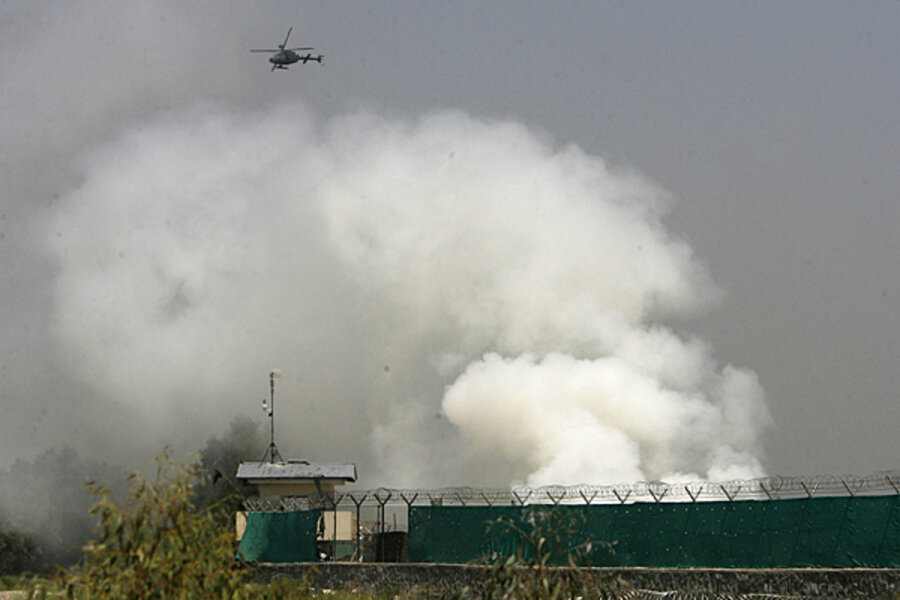Afghan Taliban attacks NATO airfield, wounding two troops
Loading...
• A daily summary of global reports on security issues.
Afghan Taliban-linked militants launched a bold daytime attack on a NATO airfield outside the eastern Afghan city of Jalalabad on Wednesday, setting off a car bomb and firing light weapons and rocket-propelled grenades in a battle that killed at least eight militants and wounded two coalition personnel.
The attack comes at a delicate time for the NATO-led International Security and Assistance Force (ISAF), just days before US General David Petraeus arrives to assume command after the ouster of US General Stanley McChrystal for insubordination. Coalition casualties are also climbing: as The Christian Science Monitor reported, June has been the deadliest month of the nine-year war for coalition troops, with 101 soldiers killed.
Wednesday’s battle began when a car bomb went off at the entrance to Jalalabad airfield, 78 miles east of the Afghan capital of Kabul near the border with Pakistan. The explosion was followed by a 30-minute gun battle with militants, says the Associated Press. Eight attackers were killed and two coalition personnel were wounded, including one Afghan soldier and one international soldier.
The New York Times reports that the attack was similar in style to the attack on Bagram Air Base in May, when a suicide bomber driving a car detonated his explosives at a gate to the base, clearing the way for Taliban fighters to enter the complex.
The BBC reports that militants attacked the Jalalabad base from multiple directions in what it calls “a commando-style raid,” a more sophisticated tactic that the Taliban has increasingly relied on to deliver heavier civilian and military casualties.
If that was the goal, then the group appears to have failed. However, in a text message sent to the Associated Press, Taliban spokesman Zabiullah Mujahid claimed that six suicide bombers had killed 32 coalition soldiers. The group is known to exaggerate its claims.
ISAF played down the significance of the attack, saying that the Taliban forces failed to breach the perimeter of the airfield or significantly disrupt its operations and that the assault’s biggest impact may have been on the media.
“This was not only an attack on a combined Afghan and ISAF facility, it was also an attack on the people of Afghanistan. The reality is that attacks such as this have absolutely no impact on the overall security situation in Afghanistan," said IJC Spokesperson Navy Capt. Jane Campbell in an ISAF press release. “While designed to garner media attention, this attack only temporarily disrupted operations as our forces successfully repelled the attack.”
Nevertheless, the attack is unlikely to calm growing unease with the ISAF war effort, which has been beset by a high-profile leadership crisis and a mounting death toll.
In Senate confirmation hearings on Tuesday, Petraeus said that coalition forces had “achieved progress in several locations” but were still in for a “tough fight,” reports Agence France Presse.
A tough fight it has been. 2009 was the deadliest year yet for coalition forces, with 521 killed according to the independent website icasualties.org. This year may be no better: six months in, the NATO death toll is already 321. In both years, the vast majority of those killed were Americans.
The Monitor reported Tuesday that ISAF officials say the increased death toll is not surprising. More casualties are part of a troop surge into rural Afghanistan to fight the Taliban on their own turf. The current strategy is to flush out the Taliban and fill the void left behind with development and governance projects.
Already, ISAF says it has killed 130 Taliban leaders in Afghanistan’s south, the organization’s traditional stronghold.
“From our perspective, while certainly these added casualties and the increased violence are unfortunate, it’s expected,” says Air Force Lt. Col. John Dorrian, an spokesman for the International Security Assistance Force (ISAF) in Kabul. “ISAF forces with their Afghan partners are challenging Taliban insurgents in territory that was in many cases completely controlled by them for years.”
Related:





